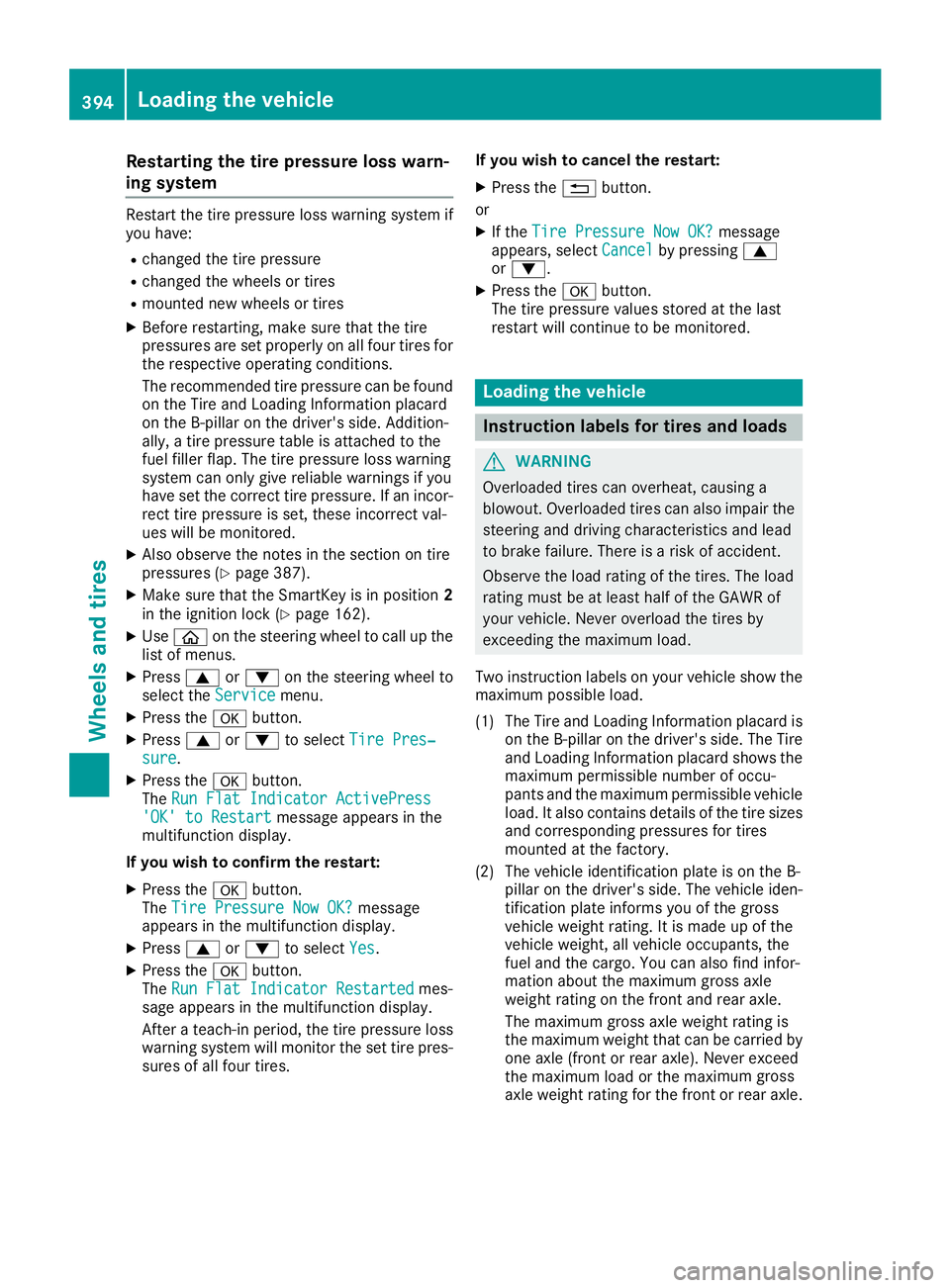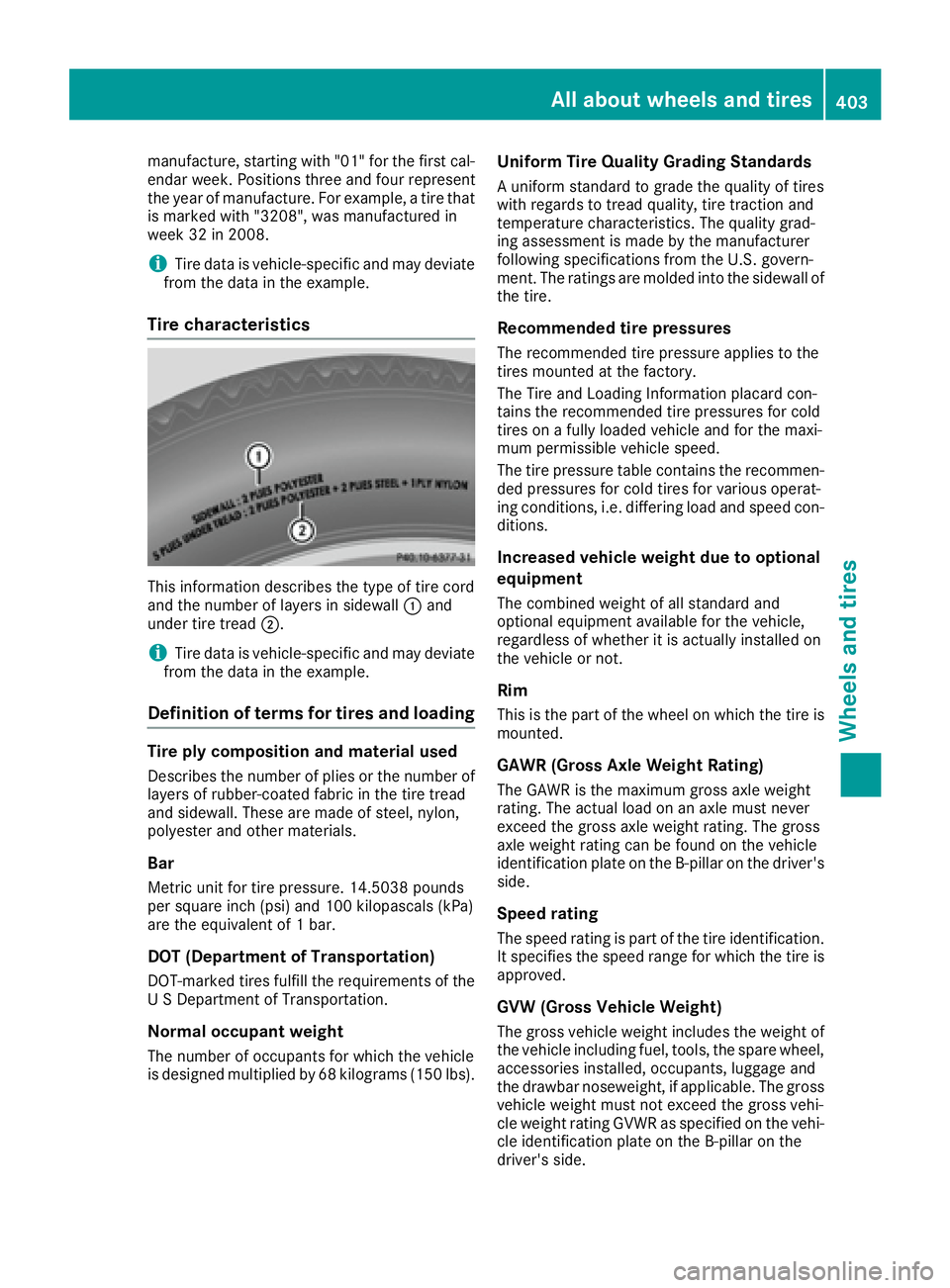2016 MERCEDES-BENZ S CLASS four wheel drive
[x] Cancel search: four wheel drivePage 5 of 438

1, 2, 3 ... 4ETS (Electronic Traction System)
see ETS/4ETS (Electronic Trac-
tion System)
4MATIC (permanent four-wheel
drive) .................................................. 213
12 V socket
see Sockets
115 V socket ...................................... 337
360° camera
Cleaning ........................................ .3 63
Function/notes ............................ .2 24
A ABS (Anti-lock Braking System)
Display message ............................ 278
Function/notes ................................ 68
Warning lamp ................................. 316
Accident
Automatic measures after an acci-
dent ................................................. 61
Activating/deactivating cooling
with air dehumidification ................. 146
Activating/deactivating Night
View Assist Plus
With spotlight function ................... 232
Active Blind Spot Assist
Activating/deactivating (on-
board computer) ............................ 271
Display message ............................ 301
Function/information .................... 234
Active Body Control (ABC)
Display message ............................ 300
Function/notes ............................. 210
Active Lane Keeping Assist
Activating/deactivating (on-
board computer) ............................ 271
Display message ............................ 301
Function/information .................... 237
Active multicontour seat .................. 117
Active Parking Assist
Detecting parking spaces .............. 217
Display message ............................ 302
Exiting a parking space .................. 219
Function/notes ............................. 216
Important safety notes .................. 216 Parking .......................................... 218
ADAPTIVE BRAKE ................................. 75
Adaptive Brake Assist
Function/notes ................................ 72
Adaptive Damping System (ADS) ..... 212
Adaptive Highbeam Assist Plus
Display message ............................ 293
Function/notes ............................. 133
Switching on/off ........................... 133
Additional speedometer ................... 274
Additives (engine oil) ........................ 430
Air bags
Belt bags .......................................... 48
Cushion air bags .............................. 53
Deployment ..................................... 57
Display message ............................ 289
Front air bag (driver, front
passenger) ....................................... 52
Important safety notes .................... 50
Introduction ..................................... 50
Knee bag .......................................... 52
Occupant Classification System
(OCS) ............................................... 53
PASSENGER AIR BAG i nd icator
lamps ............................................... 46
Side impact air bag .......................... 52
Window curtain air bag .................... 53
Air vents
Glove box ....................................... 159
Important safety notes .................. 158
Rear ............................................... 160
Setting ........................................... 158
Setting the center air vents ........... 159
Setting the side air vents ............... 159
Air-conditioning system
see Climate control
AIRMATIC
Display message ............................ 299
Function/notes ............................. 212
Alarm
ATA (Anti-Theft Alarm system) ......... 78
Switching off (ATA) .......................... 78
Switching the function on/off
(ATA) ................................................ 78
Alarm system
see ATA (Anti-Theft Alarm system)
Anti-lock braking system
see ABS (Anti-lock Braking System) Index 3
Page 215 of 438

Sports tuning The firmer setting of the suspension tuning in
SPORT mode ensures the best possible contact
with the road. Select this mode when employing
a sporty driving style, e.g. on winding country
roads.
All vehicles except Mercedes-AMG vehicles: X
If indicator lamp �D is not lit: press but-
ton �C .
Indicator lamp �D lights up. Sports suspen-
sion tuning is selected. The vehicle is lowered
by 0.4 in (10 mm) compared to the normal
level.
The AIRMATIC
SPORT message appears in the
multifunction display.
Mercedes-AMG vehicles: X
If indicator lamp �D is not lit: press but-
ton �C .
Indicator lamp �D lights up. If the driving
speed is higher than 75 mph (120 km/h), the
vehicle is automatically lowered by another
0.4 in (10 mm) compared to the normal level
in sport mode.
The AMG Suspension System SPORT mes-
sage appears in the multifunction display.
Comfort tuning
In comfort mode, the driving characteristics of
your vehicle are more comfortable. Therefore,
select this mode if you favor a more comfortable
driving style. Select comfort mode also when
driving fast on straight roads, e.g. on straight
stretches of highway. X
If indicator lamp �D is not lit: press but-
ton �C .
Indicator lamp �D lights up. Comfort tuning is
selected. All vehicles except Mercedes-AMG vehi-
cles: the AIRMATIC COMFORT
message
appears in the multifunction display.
Mercedes-AMG vehicles: the AMG Suspen‐
sion System COMFORT message appears in
the multifunction display.
If the driving speed is higher than 75 mph
(120 km/h), the vehicle is automatically low-
ered in comfort mode by 0.4 in (10 mm) com-
pared to the normal level.
Load compensation The vehicle can compensate differences in the
vehicle level by raising or lowering the axles.
4MATIC (permanent four-wheel drive) 4MATIC ensures that all four wheels are perma-
nently driven. Together with ESP ®
, it improves
the traction of your vehicle whenever a drive
wheel spins due to insufficient grip.
If you fail to adapt your driving style, 4MATIC can
neither reduce the risk of accident nor override
the laws of physics. 4MATIC cannot take
account of road, weather and traffic conditions.
4MATIC is only an aid. You are responsible for
the distance to the vehicle in front, for vehicle
speed, for braking in good time and for staying in
your lane.
If a drive wheel spins due to insufficient grip: R
Only depress the accelerator pedal as far as
necessary when pulling away. R
Accelerate less when driving.
! Never tow the vehicle with one axle raised.
This may damage the transfer case. Damage
of this sort is not covered by the Mercedes-
Benz Limited Warranty. All wheels must
remain either on the ground or be fully raised.
Observe the instructions for towing the vehi-
cle with all wheels in full contact with the
ground.
i In wintry driving conditions, the maximum
effect of 4MATIC can only be achieved if you
use winter tires (M+S tires), with snow chains
if necessary.Driving systems 213
Driving and parking Z
Page 396 of 438

Restarting the tire pressure loss warn-
ing system Restart the tire pressure loss warning system if
you have: R
changed the tire pressure R
changed the wheels or tires R
mounted new wheels or tires X
Before restarting, make sure that the tire
pressures are set properly on all four tires for
the respective operating conditions.
The recommended tire pressure can be found
on the Tire and Loading Information placard
on the B-pillar on the driver's side. Addition-
ally, a tire pressure table is attached to the
fuel filler flap. The tire pressure loss warning
system can only give reliable warnings if you
have set the correct tire pressure. If an incor-
rect tire pressure is set, these incorrect val-
ues will be monitored. X
Also observe the notes in the section on tire
pressures ( Y
page 387).X
Make sure that the SmartKey is in position 2
in the ignition lock ( Y
page 162).X
Use �
Page 405 of 438

manufacture, starting with "01" for the first cal-
endar week. Positions three and four represent
the year of manufacture. For example, a tire that
is marked with "3208", was manufactured in
week 32 in 2008.
i Tire data is vehicle-specific and may deviate
from the data in the example.
Tire characteristics
This information describes the type of tire cord
and the number of layers in sidewall �C and
under tire tread �D .
i Tire data is vehicle-specific and may deviate
from the data in the example.
Definition of terms for tires and loading
Tire ply composition and material used Describes the number of plies or the number of
layers of rubber-coated fabric in the tire tread
and sidewall. These are made of steel, nylon,
polyester and other materials.
Bar
Metric unit for tire pressure. 14.5038 pounds
per square inch (psi) and 100 kilopascals (kPa)
are the equivalent of 1 bar.
DOT (Department of Transportation)
DOT-marked tires fulfill the requirements of the
U S Department of Transportation.
Normal occupant weight
The number of occupants for which the vehicle
is designed multiplied by 68 kilograms (150 lbs). Uniform Tire Quality Grading Standards A uniform standard to grade the quality of tires
with regards to tread quality, tire traction and
temperature characteristics. The quality grad-
ing assessment is made by the manufacturer
following specifications from the U.S. govern-
ment. The ratings are molded into the sidewall of
the tire.
Recommended tire pressures The recommended tire pressure applies to the
tires mounted at the factory.
The Tire and Loading Information placard con-
tains the recommended tire pressures for cold
tires on a fully loaded vehicle and for the maxi-
mum permissible vehicle speed.
The tire pressure table contains the recommen-
ded pressures for cold tires for various operat-
ing conditions, i.e. differing load and speed con-
ditions.
Increased vehicle weight due to optional
equipment The combined weight of all standard and
optional equipment available for the vehicle,
regardless of whether it is actually installed on
the vehicle or not.
Rim This is the part of the wheel on which the tire is
mounted.
GAWR (Gross Axle Weight Rating) The GAWR is the maximum gross axle weight
rating. The actual load on an axle must never
exceed the gross axle weight rating. The gross
axle weight rating can be found on the vehicle
identification plate on the B-pillar on the driver's
side.
Speed rating
The speed rating is part of the tire identification.
It specifies the speed range for which the tire is
approved.
GVW (Gross Vehicle Weight)
The gross vehicle weight includes the weight of
the vehicle including fuel, tools, the spare wheel,
accessories installed, occupants, luggage and
the drawbar noseweight, if applicable. The gross
vehicle weight must not exceed the gross vehi-
cle weight rating GVWR as specified on the vehi-
cle identification plate on the B-pillar on the
driver's side.All about wheels and tires 403
Wheels and tires Z